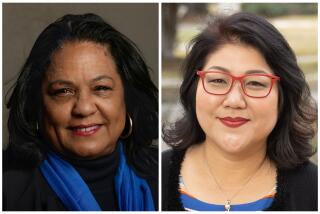Eight for the Council
The Los Angeles City Council makes decisions on behalf of a cosmopolitan city of 3 million that sprawls over 465 square miles. Fifteen council members represent districts as populous as 230,000 in the mid-Wilshire area and as large as 66 square miles in the San Fernando Valley.
Eight members of the City Council are up for reelection in the April 9 primary. We recommend one newcomer--Michael Woo, in the 13th District--and seven incumbents--Howard Finn in the 1st, Joy Picus in the 3rd, Zev Yaroslavsky in the 5th, Ernani Bernardi in the 7th, Gilbert W. Lindsay in the 9th, Marvin Braude in the 11th and Joan Milke Flores in the 15th.
Woo, who is challenging Councilwoman Peggy Stevenson, would bring fresh and creative views to a governing body, several of whose members act as though they are serving life terms. Woo’s background in urban planning would serve the city well as the council grapples with ways to make Los Angeles grow gracefully. His government experience as an aide to state Sen. David Roberti (D-Los Angeles) is also an asset.
Stevenson, a 10-year veteran, has served the district well enough--particularly elderly residents and Hollywood. But Woo is more vigorous and more in tune with the changing population of the 13th, particularly the young professionals in the Silver Lake and Los Feliz areas. Woo’s depth, scope and energy would benefit not only his district but the entire city as well.
In contrast to the spirited contest in the 13th District, there are no challenges on the ballot in three other districts. Yaroslavsky--who represents West Los Angeles, including the Fairfax area and Westwood--and Braude, who represents the far Westside, including Pacific Palisades--face no opposition. Flores--who represents the southernmost communities, including San Pedro, Wilmington and Watts--faces one write-in challenger. They deserve reelection.
Our choices for other races include Howard Finn, a first-term councilman who represents the northeast San Fernando Valley. As chairman of the Planning and Environment Committee, Finn has focused on such approaches as forcing developers to pay for problems that growth creates, instead of putting the entire burden on taxpayers. He once used money from his office budget to fund temporarily an additional police car in the Sunland-Tujunga section of his district--an idea that other council members might consider.
Joy Picus, an energetic councilwoman with strong opinions, has represented the west San Fernando Valley for two terms. She stood up to Los Angeles Police Chief Daryl F. Gates during the police spying controversy. More recently she has supported the new property tax that would pay for more police officers. She takes strong environmental positions, but she is not rigidly opposed to growth and development. Her current priorities include coping with the city’s mounting problems of toxic-waste disposal, and campaigning for more private contracting of city services to cut costs.
Ernani Bernardi has represented the section of the San Fernando Valley that includes Van Nuys since 1961. He is the council’s great dissenter, but he can accentuate the positive. While other councilmen stalled last month on the inevitable adoption of the general plan that puts limits on development, Bernardi pushed, albeit unsuccessfully, for an urgency clause to speed its effective date. He also led a fight several years ago to moderate the growth of police pension costs.
For Gilbert Lindsay, the sky is the limit when it comes to downtown growth. He encourages it, works hard at it and usually opposes efforts to block it. A veteran on the council since 1963, he has little competition, so there is no pressure to force him to pay as much attention to the needs of the neighborhoods south and east of downtown. He says that he will push for a major shopping complex near Vernon and Central avenues--part of his efforts to “rebuild my own backyard.”
Council members function as both legislators and administrators. The best of them work out com-promises and try to speed the process of government rather than delay the inevitable. Asked to solve problems as specific as street repair and tree trimming and as pervasive as the fear of crime and traffic jams, they must respond to the unique needs of their districts without losing sight of the needs of the entire city. That is a tall order, on which we believe these candidates can deliver.
More to Read
Sign up for Essential California
The most important California stories and recommendations in your inbox every morning.
You may occasionally receive promotional content from the Los Angeles Times.










